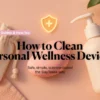Myth Vs Reality

Even in the 21st century, myths about sex are everywhere. You’ve probably heard some of them from friends, movies, or the internet – ideas like “men think about sex every seven seconds” or “you can’t get pregnant if it’s your first time.” These misconceptions might range from humorous to harmful, but all of them can lead to confusion, insecurity, or risky choices. It’s time to set the record straight with facts. In this post, we’ll debunk 10 common sex myths you need to stop believing. By busting these myths, we hope to empower you with accurate knowledge for a healthier, more confident, and sex-positive life. Let’s dive in!
Myth 1: Sex = Penetration (Only Intercourse Counts as “Real” Sex)
Many people assume that “sex” by definition means penis-in-vagina intercourse – everything else is just “foreplay.” This myth couldn’t be further from the truth. In reality, sex is not limited to penetration. Oral sex, manual stimulation, outercourse, and other intimate activities are all valid forms of sexual expression. What “counts” as sex depends on personal definitions and the people involved. In fact, LGBTQ+ individuals often have a broader definition of sex that doesn’t center on intercourse.
Believing this myth can create unnecessary pressure or make some couples feel like they’re not having “real” sex if penetration isn’t involved. The truth is that satisfaction isn’t about a single act – it’s about mutual pleasure and connection. Non-penetrative sex can be just as intimate and fulfilling. By expanding our view of sex beyond intercourse, we open up a world of possibilities for closeness and pleasure (and take the pressure off the idea that sex has to follow one script).
Myth 2: Men Are Always Horny (Men Think About Sex Constantly, Women Don’t)
We’ve all heard the saying that “men think about sex every 7 seconds.” This is a persistent myth that paints men as sex-crazed creatures and implies women are far less interested. Let’s bust this one with science. A famous study on college students found that men thought about sex around 19 times per day on average, while women thought about sex roughly 10 times per day. That’s nowhere near every 7 seconds, and the gap between genders wasn’t as huge as the stereotype suggests.
The idea that men are naturally more sexual than women is an outdated social narrative. In reality, libido varies greatly from person to person, regardless of gender. Plenty of women have high sex drives, and some men have lower drives – and that’s completely normal. Social conditioning plays a big role here: men are often encouraged to brag about sexual thoughts, while women may downplay theirs due to societal expectations. The bottom line? Interest in sex isn’t determined by your gender. Everyone is different, and believing this myth can create unfair expectations (like assuming a man is “always up for it” or a woman “naturally” has low desire). It’s healthier to communicate with your partner about their individual desires rather than relying on gendered assumptions.

Myth 3: “Bigger Is Better” (Penis Size Is the Key to Good Sex)
This myth has caused countless men needless anxiety and spawned endless jokes in pop culture. The belief that a larger penis equals better sex is overblown (pun intended). While porn and locker-room talk glorify size, research shows that most women don’t actually prioritize penis size for sexual satisfaction. In fact, 85% of women are happy with their partner’s size, and many straight women say they don’t particularly care about it. When it comes to pleasure, technique, communication, and emotional intimacy matter far more than length or girth.
Of course, it’s natural for some people to have preferences, but the idea that only big equals good is false. A penis that’s too large for a partner can even cause discomfort. Plus, sexual pleasure isn’t one-size-fits-all (so to speak) – what feels good varies for each person. There are many ways to please your partner that have nothing to do with size at all. If size insecurity is stressing you out, remember that confidence and attentiveness are sexier than inches. As one expert notes, pleasure comes down to much more than penis length. So let’s lay this myth to rest: great sex is about connection and skill, not a measurement on a ruler.
Myth 4: If Your Partner Isn’t Physically Aroused, They’re Not Attracted to You
It’s easy to panic if he loses his erection or she isn’t naturally lubricated during intimate moments. Some people assume this means “uh oh, my partner must not really be attracted to me.” But that’s a myth that overlooks basic biology and context. Physical arousal (like erections or vaginal wetness) doesn’t always sync perfectly with mental arousal or desire. In other words, the body isn’t a lie detector for attraction.
There are many reasons someone might not exhibit expected arousal signs in the moment: stress, fatigue, hormonal changes, medications, anxiety, or simply needing more time and stimulation. Men sometimes get erections even when they’re not turned on, and women can lubricate without feeling lust – and the reverse is true: someone can be very turned on yet their body isn’t cooperating that day. It happens! Our bodies are not machines.
Instead of taking it personally, communicate and relax. If a partner isn’t getting physically aroused right away, it might just mean they need more time or a different type of stimulation. Create a comfortable, low-pressure environment: focus on kissing, foreplay, and what feels good rather than checking for specific responses. By debunking this myth, you’ll avoid a lot of needless insecurity. Attraction is complicated, and one temporary physical response isn’t a verdict on how sexy they find you.

Myth 5: Watching Porn Will Ruin Your Sex Life
Pornography is often blamed for everything from failing relationships to unrealistic expectations. There’s a widespread myth that “porn will inevitably damage your intimacy or turn you into an addict.” The truth is more nuanced. Watching porn in moderation does not automatically ruin your sex life or relationship – it really depends on how it’s used and the individuals involved. Some experts note that people can consume porn without issues; problems arise if it becomes compulsive or a substitute for real intimacy.
It’s certainly true that porn often presents a distorted, fantasy version of sex. Bodies tend to be “idealized,” encounters are exaggerated, and important elements like consent, communication, and contraception are often missing. If someone believes porn is an instruction manual, it can lead to misunderstandings (because real-life sex isn’t scripted or flawlessly airbrushed). However, occasional porn use by itself isn’t a kiss of death for your love life. In fact, some couples watch adult films together as a way to spark conversation or explore fantasies in a safe way.
The key is to view porn critically and balance it with open communication. Recognize that it’s entertainment – not education. If you find porn is negatively affecting your expectations or behavior, consider taking a break and focusing on real-world intimacy. And if one partner enjoys porn and the other doesn’t, it’s important to discuss boundaries and feelings openly, rather than letting this myth create fear or guilt. Porn isn’t a one-way ticket to dysfunction – but believing the myth blindly can cause panic. Stay aware and communicate with your partner for a healthy balance.
Myth 6: You’re Either Naturally Good at Sex or You’re Not
Many people secretly worry about whether they’re “doing it right” in bed. This leads to the myth that some people are just born amazing lovers and if you’re not a natural, well, too bad. False! Sex is a skill like any other – which means everyone can learn and improve with time, communication, and experience. Believing that you’re either “good or bad” at sex as an unchangeable trait is harmful because it discourages growth and openness.
Think about it: no one emerges from the womb knowing how to drive a car or play a guitar; we learn and practice. Similarly, great lovers are made, not born. Sure, people have different levels of confidence or intuition at first, but the most important ingredients for a satisfying sexual connection are communication, empathy, and willingness to learn what your partner (and you) enjoy. These are all things you can develop over time.
If you’re with a new partner, remember that it takes time to learn each other’s bodies and preferences. Even with a long-term partner, trying new things and talking about what feels good will enhance your connection. Don’t buy into the fatalistic myth that you’re just “bad at sex” if an encounter doesn’t go like a movie scene. Instead, treat sex as a journey. Couples who communicate and adapt tend to have much better sex lives than those who assume skill is innate. So throw out the notion of “natural talent” in the bedroom – enthusiasm and effort are what truly shine.

Myth 7: Sex Stops When You Get Older
A particularly ageist myth is the belief that older adults don’t (or shouldn’t) have sex – essentially that one’s sex life expires after a certain age. This is absolutely untrue. While it’s normal for sexual frequency or the way we have sex to change with age (due to health or hormonal shifts), many people remain sexually active and enjoy intimacy well into their senior years. In one study in the UK, 54% of men and 31% of women over 70 reported being sexually active. Clearly, a healthy sex life isn’t just for the under-40 crowd!
What does tend to change with age is how we approach sex. Older couples might place more emphasis on emotional intimacy, foreplay, and comfort. Issues like erectile dysfunction or vaginal dryness may appear, but there are solutions (from medical treatments to lubricants and honest communication about needs). In fact, many older adults report greater sexual satisfaction thanks to fewer inhibitions and no worries about pregnancy. They often have more time and confidence to enjoy sex than they did in their busy younger years.
The stigma that grandma and grandpa shouldn’t be sexual is not only wrong, it can also be hurtful. It may discourage seniors from seeking help for sexual issues or from embracing that part of life. Let’s bust this myth: desire doesn’t automatically disappear with wrinkles. People of any age can crave and enjoy intimacy. By recognizing that seniors have sexual needs too, we promote a more inclusive, respectful understanding of sexuality across the lifespan.
Myth 8: Using Sex Toys Means Something Is Wrong with Your Relationship
Some folks believe that if you bring a vibrator or other sex toy into the bedroom, it must mean your partner isn’t “enough” for you or that your sex life is lacking. Not true! Sex toys are tools, not competitors. Enjoying toys doesn’t mean your partner is failing – it just means you’re open to enhancing pleasure in new ways. Think of it this way: using a vibrator is no different than using a fancy kitchen gadget – it can add some convenience or spice things up, but it doesn’t replace the chef. 😉
The myth that “only unsatisfied people use toys” likely comes from insecurity or lack of understanding. In reality, many happy couples use sex toys together to explore different sensations, add novelty, or assist with issues like difficulty orgasming. Toys can stimulate in ways human hands or anatomy might not, and that’s okay. They can boost arousal and connection rather than detract from it. For example, a vibrator can be a fun addition during foreplay or even incorporated during intercourse to help one or both partners climax more easily.
Introducing a toy should be done with mutual consent and curiosity. If both partners see it as a team player in their sexual repertoire, it can actually increase intimacy – you’re sharing fantasies, communicating desires, and learning together. Remember, using a sex toy isn’t a sign of failure; it’s a sign you care about each other’s pleasure and are willing to experiment. So toss the shame aside. There’s nothing “wrong” with your relationship if you enjoy toys – in fact, it might just indicate a very open and healthy line of communication.
Myth 9: You Can’t Get Pregnant (or STI) If… You Do It Standing Up, During Your Period, or It’s the First Time
There are so many versions of this myth: “You can’t get pregnant if it’s your first time,” “You can’t get pregnant during your period,” “You can’t get pregnant if you do it standing up or in water,” and so on. Let’s be clear: if you have unprotected sex, pregnancy is possible – no matter what position or timing, including the first time. Sperm are tiny but determined swimmers; if semen gets in or near the vagina, there’s a chance it can lead to pregnancy. Standing up or doing jumping jacks afterward won’t change that. And while it’s less likely (but not impossible) to conceive during menstruation, sperm can live inside a female body for up to 5 days, so pregnancy can still occur from period sex in some cases.
A related myth is “If he pulls out, she won’t get pregnant.” The withdrawal method (pulling out) is notoriously unreliable because pre-ejaculate fluid can contain sperm. It only takes one sperm to fertilize an egg, and pre-cum can carry enough sperm to cause pregnancy. So, no – the “pull-out game” is not a foolproof strategy.
Now let’s talk STIs (sexually transmitted infections). Some people think “You can’t catch an STI if you only do oral” or “you won’t get an STI if your partner is ‘clean-looking’ or it’s their first time.” Wrong. Any unprotected sex (oral, anal, vaginal, even genital skin-to-skin contact) can transmit STIs if one person is infected. And you often cannot tell by appearance or by their sexual history if someone has an STI. Many infections show no immediate signs, especially in the early stages. Bottom line: There are no magical exceptions – pregnancy and STIs are risks whenever you have unprotected sex, so use protection (like condoms/dental dams and reliable birth control) if you’re not planning a pregnancy or if you’re not 100% certain both of you are STI-free. Don’t rely on myths; rely on protection and honest communication.
Myth 10: You Would Know If You or Your Partner Had an STI
This myth can be dangerous. People often assume that having an STI (sexually transmitted infection) is always obvious – like there will be clear symptoms or “something off” that lets you know. The truth is, many common STIs can be completely asymptomatic (show no symptoms). For example, chlamydia and gonorrhea often have zero noticeable signs, especially in women, yet they can cause serious harm if left untreated. HPV (human papillomavirus) is another infection that many carry without knowing, and it can be spread even without symptoms.
Believing you or your partner must have symptoms if infected leads to a false sense of security. Someone might say, “I’m fine, I got no itching or anything, so I must be clean.” In reality, the only way to know your STI status (or your partner’s) is to get tested. This myth also ties into a stigma that only people with lots of partners get STIs, which is untrue – anyone can contract an infection from even a single encounter if protection isn’t used. STIs don’t care about your “reputation”; they only need an opportunity to spread.
To stay safe, make STI testing a normal part of your health routine if you’re sexually active. Many doctors recommend getting tested at least once a year, or between partners. Also, have open conversations with partners about sexual health and don’t assume “no news is good news.” By rejecting the myth that you’d automatically see an STI, you take a proactive stance: use protection and get regular check-ups. It’s the best way to protect both your health and your peace of mind.

Conclusion & Soft CTA
Sex is a natural and wonderful part of life – and so is learning about it. By debunking these 10 common sex myths, we hope you feel more informed, confident, and empowered to make smart decisions about your body and relationships. Knowledge is power when it comes to sexual wellness, and breaking free from these misconceptions can lead to healthier attitudes and better communication with your partners.
Remember, everyone’s sexual journey is unique. Don’t let myths or stereotypes define yours. If something doesn’t feel right or you have questions, seek out factual, sex-positive resources (and speaking with a healthcare professional is never a bad idea for guidance).
Lastly, if you found this post helpful, feel free to share it with others who might appreciate a myth-busting reality check. 😉 At Slytease, we’re dedicated to providing judgment-free, educational, and engaging content on sex and relationships. Stay tuned for more guides and articles to help you build a happier, healthier sex life. And if you have any topics you’d love for us to cover next, let us know – we’re all ears!
Here’s to embracing the facts and enjoying a more informed, satisfying love life. Happy learning and stay sexy (and safe)!




